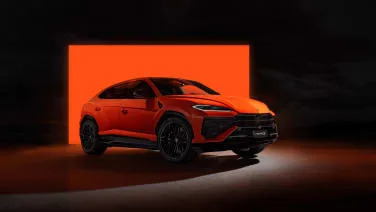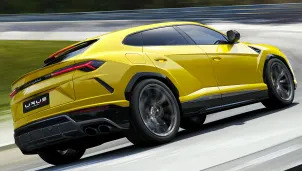2019 Lamborghini Urus
PALM SPRINGS, Calif. — The Lamborghini Urus is a strange beast. It's generally shaped like a modern Lamborghini, a thick wedge with knife-edged angles, but its four-door form brings a practicality that no previous Lamborghini could match. Not even the iconic LM002, a thinly veneered military vehicle more similar to the classic Steyr-Daimler-Puch Geländewagen than the Urus, which is a crossover and fundamentally meant to appeal to a much broader audience. We flew to California at the height of snowbird season to drive this $200,000 SUV. We wanted to focus on the wonderful weather and Urus' abilities on the track rather than debating whether or not it truly is a product of Sant'Agata Bolognese. Models like this attract new customers to the brand, and the company expects the Urus to double sales. To succeed, it needs to have the sex appeal and performance to back up the Lamborghini name, not necessarily be a direct link to the Huracan or Avendator. There's a Volkswagen Group feel to the whole design, discernable even under the camouflage of hexagonal shapes. That's no surprise, as the Urus rides on the same platform as the Audi Q8, Bentley Bentayga and Porsche Cayenne. The hardpoints can't change, and the sharp lines remind you more than a little of the Q8. And the 4.0-liter twin-turbo V8's exhaust note betrays the Urus' German roots, too. The engine – again shared with other VW products – sounds beefy and mean, but doesn't sing quite the same sweet tune you expect from an Italian performance car, especially when your foot is nailed to the floor. The Urus' interior, too, has a distinct Audi aura. The leather is fantastic, especially in saddle brown like our main test vehicle, but the digital instrument cluster is lifted straight from Audi, as are the steering wheel, window and lock switches, infotainment system and more. It's mostly quality stuff, but it feels like pieces from a parts-bin when some of the touch points on a $200,000 SUV are the same as a $35,000 sedan. It's also a problem that the Porsche Cayenne and Bentley Bentayga don't have. The things Porsche and Bentley could change — gauges, switches, lock buttons and more — they did change. Those two feel like more distinct products and less like a different wrapper on the same candy bar. It feels like Lamborghini skimped on some of the details. Look, Audi makes great stuff, but it makes the Urus feel less special. But on the track, you move the Urus around like you're swinging a sledgehammer. At 4,843 pounds, it's big and heavy, sure, but the all-wheel-drive system makes it easy to put each and every one of its 641 horsepower and 627 pound-feet of torque to the ground. It hits 60 mph in about 3.5 seconds, topping out at 190 mph. The Urus has a standard 40/60 front to rear torque split, though up to 80 percent can be sent to the rear or 50 percent to the front as …
Full Review
PALM SPRINGS, Calif. — The Lamborghini Urus is a strange beast. It's generally shaped like a modern Lamborghini, a thick wedge with knife-edged angles, but its four-door form brings a practicality that no previous Lamborghini could match. Not even the iconic LM002, a thinly veneered military vehicle more similar to the classic Steyr-Daimler-Puch Geländewagen than the Urus, which is a crossover and fundamentally meant to appeal to a much broader audience. We flew to California at the height of snowbird season to drive this $200,000 SUV. We wanted to focus on the wonderful weather and Urus' abilities on the track rather than debating whether or not it truly is a product of Sant'Agata Bolognese. Models like this attract new customers to the brand, and the company expects the Urus to double sales. To succeed, it needs to have the sex appeal and performance to back up the Lamborghini name, not necessarily be a direct link to the Huracan or Avendator. There's a Volkswagen Group feel to the whole design, discernable even under the camouflage of hexagonal shapes. That's no surprise, as the Urus rides on the same platform as the Audi Q8, Bentley Bentayga and Porsche Cayenne. The hardpoints can't change, and the sharp lines remind you more than a little of the Q8. And the 4.0-liter twin-turbo V8's exhaust note betrays the Urus' German roots, too. The engine – again shared with other VW products – sounds beefy and mean, but doesn't sing quite the same sweet tune you expect from an Italian performance car, especially when your foot is nailed to the floor. The Urus' interior, too, has a distinct Audi aura. The leather is fantastic, especially in saddle brown like our main test vehicle, but the digital instrument cluster is lifted straight from Audi, as are the steering wheel, window and lock switches, infotainment system and more. It's mostly quality stuff, but it feels like pieces from a parts-bin when some of the touch points on a $200,000 SUV are the same as a $35,000 sedan. It's also a problem that the Porsche Cayenne and Bentley Bentayga don't have. The things Porsche and Bentley could change — gauges, switches, lock buttons and more — they did change. Those two feel like more distinct products and less like a different wrapper on the same candy bar. It feels like Lamborghini skimped on some of the details. Look, Audi makes great stuff, but it makes the Urus feel less special. But on the track, you move the Urus around like you're swinging a sledgehammer. At 4,843 pounds, it's big and heavy, sure, but the all-wheel-drive system makes it easy to put each and every one of its 641 horsepower and 627 pound-feet of torque to the ground. It hits 60 mph in about 3.5 seconds, topping out at 190 mph. The Urus has a standard 40/60 front to rear torque split, though up to 80 percent can be sent to the rear or 50 percent to the front as …
Hide Full Review
Hide Full Review
Retail Price
$200,000 - $200,000
MSRP / Window Sticker Price
| Engine | 4.0L V-8 |
| MPG | Up to 12 city / 17 highway |
| Seating | 5 Passengers |
| Transmission | 8-spd auto w/OD |
| Power | 641 @ 6000 rpm |
| Drivetrain | all wheel |
| Curb Weight | 4,844 lbs |
Smart Buy Program is powered by 





